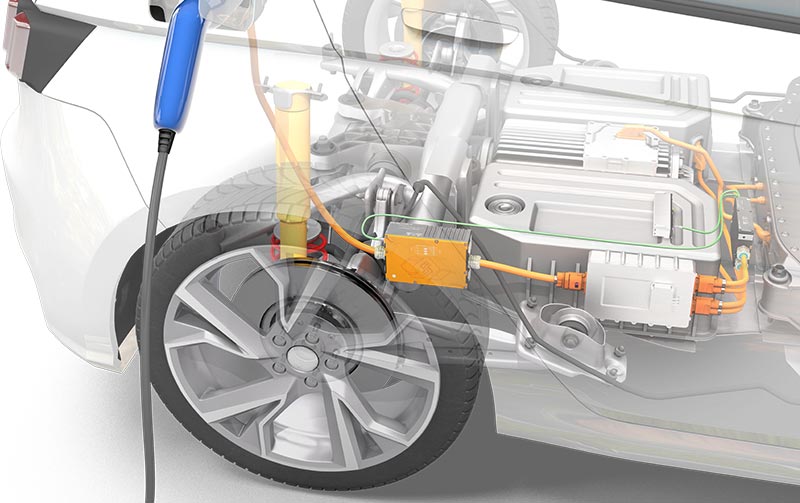Testing the interoperability of on-board chargers and AC charging stations
AC charging stations are standard for everyday charging of EV batteries. In order for electric vehicles to remain attractive to end users, AC charging must work easily worldwide. An on-board charger (OBC), for converting the charging alternating current (AC) into direct current (DC), is therefore an indispensable vehicle component. Vehicle manufacturers validate newly developed OBCs with interoperability tests before series production. However, the charging stations are also a source of errors that must be checked, as they play a key role in the overall quality of the charging process. With the HV Breakout Module (HV BM) 3.1 OBC from CSM, these charging processes can be examined with regard to applicable standards and country-specific characteristics.

Testing worldwide
In order for newly developed vehicles to be sold internationally, corresponding AC charging tests must be carried out worldwide. While a three-phase system usually dominates the low-voltage distribution network in Europe, the split-phase network, a single-phase three-wire system, is established in the USA. Among other things, this results in a wide variety of plug systems, charging station and wallbox types as well as different software that needs to be tested. Likewise, potential repercussions when charging the electric vehicle must be ruled out and compliance with applicable power quality standards must be confirmed.
Measurement Task
Worldwide measurement of current and voltage between charging stations and electric vehicles for analyzing charging processes.

Measurement of grid quality
With a lean measurement setup the necessary measurements can be carried out during the charging process. With the Vector software CANape or vMeasure and the included eMobilityAnalyzer function library, the necessary analyses and verifications can be carried out to examine the current and voltage curves of the phases with regard to amplitude, curve shape and limit values.
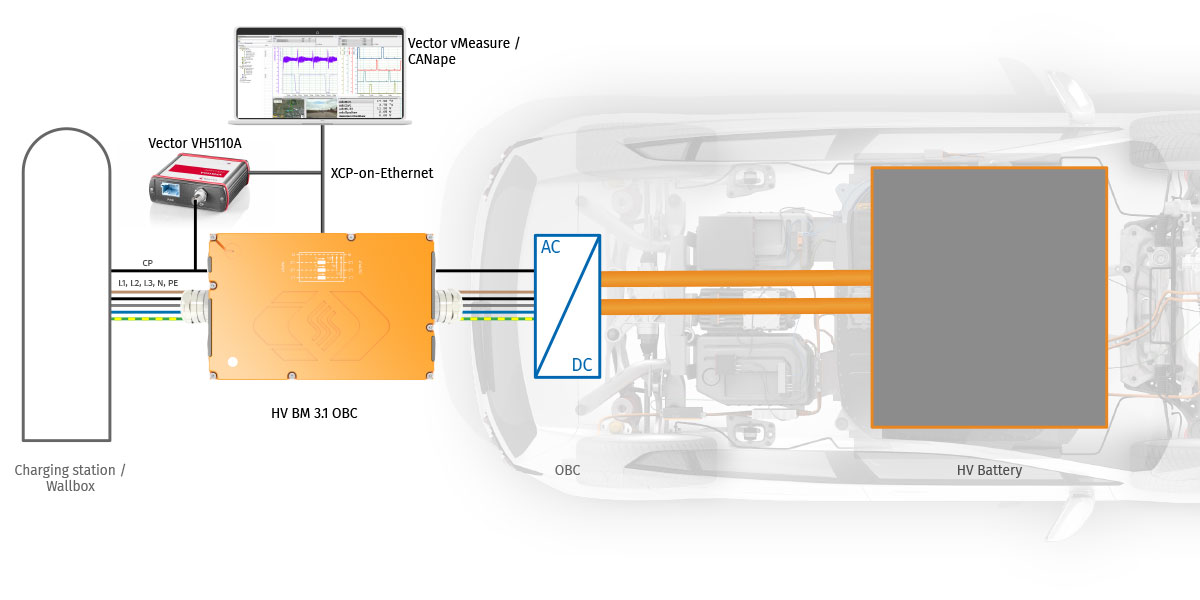
Acquisition of CP low-level communication
The charging cable contains an additional CP (Control Pilot) conductor, which is used to regulate the charging control between the charging station and the electric vehicle. Pulse width modulation (PWM) is used for low-level communication between the electric vehicle and the charging station. This signal can be recorded simultaneously with a CSM AD4 measurement module. Alternatively, a Vector VH5110A "CCS Listener" can be installed in the measurement setup. This can be used to record the communication between a charging station (EVSE) and electric vehicle (EV) based on CCS and NACS standards.
Charging cycle power loss
In most cases, test vehicles for testing interoperability are equipped with built-in measurement technology. If, for example, an HV BM 1.2 is installed between the OBC and the HV battery in the vehicle, the energy supplied to the battery can be measured during the charging process. The Vector eMobilityAnalyzer has a prepared ChargerEfficiency function for this measurement, which calculates the various efficiency parameters in real time:
- OBC input and output power
- OBC efficiency
- Total energy provided by the OBC for the HV battery
- Total efficiency
- Charging cycle power loss

One module - many possible applications
The HV BM 3.1 OBC can be used flexibly for high-voltage safe measurements at various points during AC charging. With the high sampling rate of up to 2 MHz, fast events such as switch-on and switch-off currents or transient voltage peaks, which lead to charging process interruptions and malfunctions, can be examined in detail.

More information
Further Information
-
CSM Xplained: Testing of fuel cell drives on test benches and in road testing
-
CSM Xplained: Maintenance of HV measurement technology – calibration and insulation-test
-
CSM Xplained: The Vector CSM E-Mobility Measurement System
-
CSM Xplained: Voltage measurement in e-mobility
-
CSM Xplained: Current measurement in e-mobility
-
CSM Xplained: Autonomous power measurement in road tests and on test benches
Related Products
Related Hardware
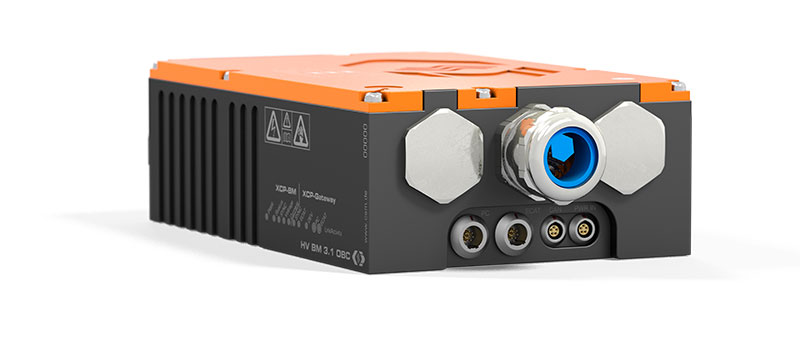
HV Breakout Module 3.1 OBC
Single- to three-phase measurement of current, voltage and power on cables carrying mains voltage for worldwide use
The HV Breakout Module (HV B) 3.1 OBC (on-board-charger) is particularly suitable for measurements during AC charging processes of electric and hybrid vehicles due to its current measurement ranges.
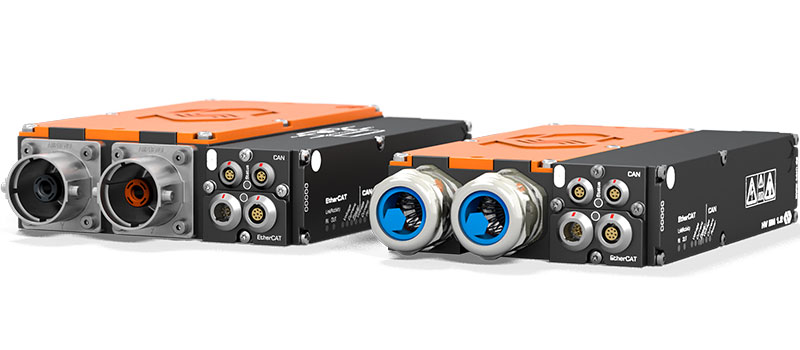
HV Breakout Modules 1.2, 1.2C
Single-phase measurement of internal conductor current and voltage
The HV Breakout Modules (BM) Type 1.2 have been specially designed for safe and precise single-phase measurement in separated HV+ and HV- power cables. Inner conductor current and voltage are measured directly and the instantaneous power is calculated in the module.
Related Software
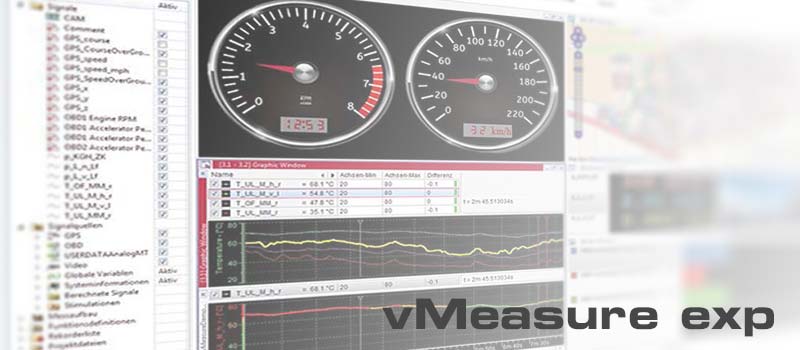
vMeasure
Reliably Solving Complex Measurement Tasks
vMeasure, developed by Vector Informatik, is an easy-to-use software tool for the acquisition and analysis of measurement data that can be used in combination with all CAN- and EtherCAT®-based CSM measurement modules. CSMconfig was integrated directly to ensure swift configuration.
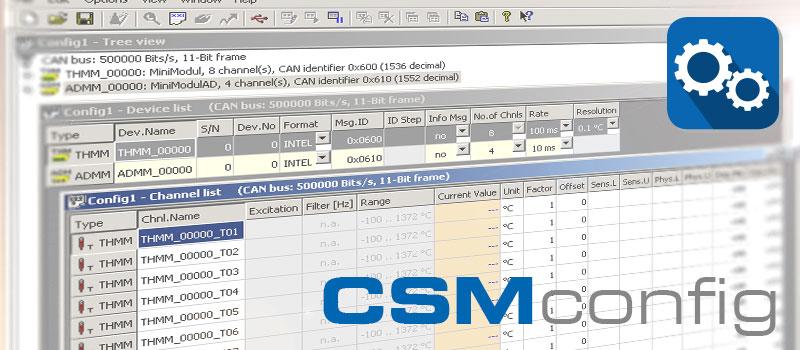

Swift configuration of measurement chains: CSMconfig is the reliable configuration software for all CAN and EtherCAT® based measurement modules from CSM. The clearly arranged and easy-to-use user interface allows an easy setting of all measurement parameters. This helps speeding up the measurement setup considerably.

 Home
Home Newsletter
Newsletter


